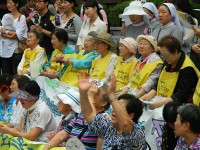There were many painful and disturbing legacies that countries had to face after the end of World War II. The most obvious is Germany. France had its own demons to deal with concerning Vichy France and its collaboration with the Nazis (France was the only Allied country to collaborate with the Germans). It wasn’t until 16 July 1995 that the French President Jacques Chirac publically acknowledged and accepted responsibility for France’s collaborationist role.

Recently, Japan has apologized to Korea for its role in “recruiting” women to serve in brothels set up for its soldiers during World War II. These women have been called “Comfort Women” and no agreement has ever been reached as to whether they were kidnapped or volunteered. One thing most historians agree on is that once in the brothels, the women were not allowed to leave. I suppose that in the strictest sense, this meant these women were sex slaves.
As part of my research into my new book Where Did They Put the Gestapo Headquarters? A Walking Tour of Nazi Occupied Paris (1940–1944), I found that Paris had more than one hundred brothels at the time of the Occupation and the Germans took over approximately twenty-two. The most opulent ones were reserved for German officers and visiting dignitaries.
Brothels were legal in France until 1946 when a law was passed banning their existence (yet, prostitution is still legal today). During the Belle Époque (roughly 1880 through 1914), brothels reached their zenith. More than 250 were located in Paris and the most luxurious, notorious, and expensive brothel was la Chabanais (opened in 1878—12 Rue Chabanais). That is until 1924 when the One-Two-Two was opened (at 122 Rue de Provence) and out did la Chabanais for being opulent, gaudy, and expensive. During the Occupation it was the One-Two-Two club the Germans commandeered for their army officers and high-ranking people of society, government, and industry (most were French collaborationists). German guards were stationed in front of the entrance when high-ranking Nazis visited (Göring was a frequent visitor).
Napoléon was the first to regulate the brothels. He made it mandatory that a doctor examined the women every two weeks. The exteriors of the brothels were to be discreet: no signage, windows shuttered, and nothing to indicate what activities occurred behind the front door. The owner/Madame had to be a woman (and ex-prostitute) as the politicians and police did not want pimps involved.

If you’ve been to Paris you will recall that street numbers are very uniform: blue and white. That is until you pass by a storefront where the number is very ornate. These were created to identify the building as housing a brothel. Remember, no signage was allowed so once a patron saw the special number, he knew he was in the right place. The best example of this is the former bordello known as Miss Betty’s at 36 Rue Saint-Sulpice. It is located across the street from the church, Saint-Sulpice. It is always been rumored that a room was dedicated for the pleasure of clients who worked at the church. Miss Betty specialized in dominatrix role-play.
After the Liberation of Paris and France, the brothel prostitutes paid a heavy price for their Occupation roles. They were labeled “horizontal collaborationists” and many of them were branded by having their heads shaved, marched naked through the streets, and in some cases, permanently physically scarred.
BBC NEWS: ‘COMFORT WOMEN’ – A PAINFUL LEGACY FOR TOKYO AND SEOUL
It is estimated that more than 200,000 women were sent to the Japanese brothels. Only 46 survivors in South Korea have been identified. We can only hope they will be well compensated by the Japanese government.
We need your help
Please tell your friends about our blog site and encourage them to visit and subscribe. Sandy and I are trying to increase our audience and we need your help through your friends and social media followers.
Sandy and I appreciate you visiting with us. We have some exciting things on the horizon and we’ll keep you updated as we go along.
What’s New With Sandy and Stew?
Stew is working on creating the walks and individual stops for the next books: Where Did They Put the Gestapo Headquarters?—A Walking Tour of Nazi Occupied Paris (1940–1944). It’s clear that almost every building in Paris has a story associated with the Occupation years. It is a matter of identifying them and then prioritizing the stops for you. This is quite a process considering the tangents and rabbit holes I end up going down. But it is a lot of fun if not quite depressing at times. One of my friends, Mark Vaughan, has suggested a walking tour book based on Napoléon. What do you think?
We have a lot of stories and we’re looking forward to sharing these with you. Please continue to visit our blog site and perhaps you’d like to subscribe so that you don’t miss out on our blog posts, past and current.
We have a lot of stories and we’re looking forward to sharing these with you. Please continue to visit our blog site and perhaps you’d like to subscribe so that you don’t miss out on our blog posts, past and current.
Share This:
Follow Stew:
Find Stew’s books on Amazon and iBooks.
Please note that we do not and will not take compensation from individuals or companies mentioned or promoted in the blogs.
Walks Through History
Copyright © 2016 Stew Ross
